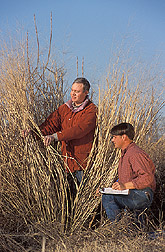This page has been archived and is being provided for reference purposes only. The page is no longer being updated, and therefore, links on the page may be invalid.

Technicians Calvin Vick (left) and John Massey measure switchgrass stem density at Little Topashaw Creek in Mississippi. Click the image for more information about it.
Read the magazine story to find out more.
A Little Creek That Could Help Repair Waterways
By Luis Pons
May 3, 2004
It may not be among the great rivers, but Little Topashaw Creek in north-central Mississippi is vital to Agricultural Research Service scientists seeking ways to best repair damaged waterways.
The 10-mile-long creek--which, when swelled, can pack a wallop within its curving, 20-foot-high banks--is one of thousands of U.S. waterways that have endured accelerated erosion due to neglect, poor management practices and channelization.
This situation led ARS hydraulic engineer Doug Shields and his colleagues at the agency's National Sedimentation Laboratory in Oxford, Miss., to launch the Little Topashaw Creek Stream Corridor Rehabilitation Project, which turned a two-mile stretch of the creek into a research site.
Controlling streambank erosion traditionally requires costly stone or concrete structures. According to Shields, who is in the lab's Water Quality and Ecological Processes Research Unit, they're evaluating tools such as large woody debris structures, willow cuttings, switchgrass hedges and submersible pumps as cost-effective ways of stabilizing streambanks and making up for past watershed abuse.
The large woody debris structures--uprooted trees stacked in crossing layers and anchored to the streambed with steel cables--can replicate an essential component of stream aquatic habitat, as well as reduce sediment transport. They cost 20 to 50 percent of the price of stone bank protection structures.
Meanwhile, Shields and University of Memphis wetland plant physiologist Reza Pezeshki are studying revegetation of eroded riparian streambanks by planting soaked dormant black willow (Salix nigra) cuttings, or posts. Soaking seems to significantly enhance the posts' ability to take root and survive during the first year. Soaked posts survived at a rate of 64 percent, while unsoaked posts survived at a 53 percent rate.
Read more about this research in the May issue of Agricultural Research magazine.
ARS is the U.S. Department of Agriculture's chief scientific research agency.
